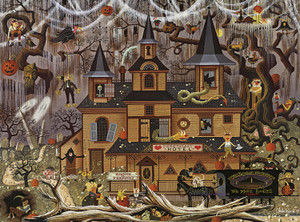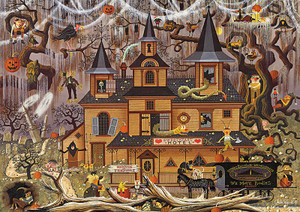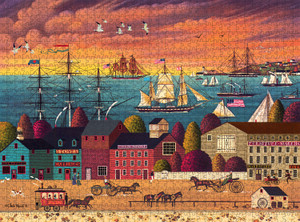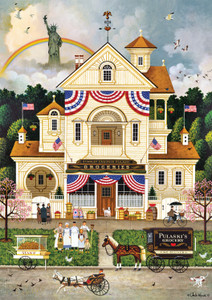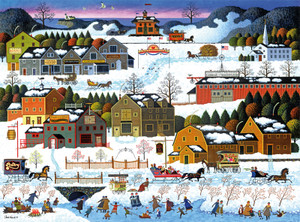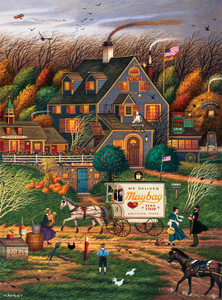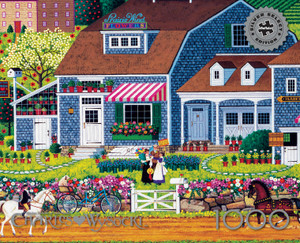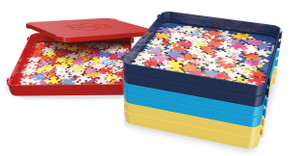Posted by Buffalo Games on Apr 29th 2022
Is There an App to Help Put Puzzles Together?
Like any kind of puzzle, jigsaw puzzles can be both exciting and challenging. Indeed, the challenge makes completing a particularly difficult puzzle feel like a hard-won victory.
Sometimes, you want to work on a puzzle to relax, refresh, and refocus your mind. Maybe you just want a fun way to spend an afternoon with family or friends. Getting stuck on a complex, 2000-piece puzzle — particularly one you started with others but were left to finish alone — can be frustrating.
If you’re not making much headway and days are turning into weeks with a puzzle left partially finished on a table that you need for other purposes, you might start looking for a bit of help.
Are there apps that can assist you in unpuzzling the pieces you have left on your colorful Aimee Stewart puzzle, or at least give you a leg up to get past a block and proceed?
As it turns out, there are a few apps designed for this purpose, but neither may be terribly useful to the average puzzle aficionado. What are these apps? How do they work, and can they help you complete 1000-piece jigsaw puzzles that have you stumped?
Zolver
The Zolver program, created by students in Python for Linux, is designed to solve real-world and virtual puzzles. It does so using a binary process of comparing the original image and the pieces, cataloging the perimeter of pieces, separating pieces into categories, and then matching them up.
There are two potential downsides to this program, though. For one thing, most people don’t use Linux, and it may not be compatible with Windows, not to mention mobile applications. Additionally, it can only solve puzzles up to 50 pieces, so even with 100 or 300-piece puzzles, you’re out of luck.
Computer Vision Solutions
You may have heard of computer programs that can take scanned information, such as pieces of shredded documents, and reassemble the source material to reconstruct the original image. It makes sense that the same type of software might be used to piece a puzzle together.
This is the basic approach behind the Automatic Jigsaw Puzzle Solver from Abto Software. How does it work? It uses pattern recognition, which is surprisingly similar to the human brain's ability to solve puzzles. It just does it a lot faster and without the aid of the original image to work from.
The process begins with cropping or separating the puzzle pieces from the background color to create unique contours for the pieces. Next, the program identifies the inner and outer locks on the pieces (also commonly referred to as “tabs” or protrusions and “blanks” or cut-ins). The program notes multiple points of convexity so it can align the pieces in an “upright” position.
Next, the program determines the orientation of pieces within the puzzle, creating several versions that accommodate different rotations. Finally, elimination occurs as the pieces are joined, and versions of alignment that are no longer needed are discarded.
The program also uses colors to match up pieces, some of which may have extremely similar contours. Complex algorithms accomplish the many steps of this process nearly automatically, and the final step is to create a visual rendering of the pieces coming together to form the final image.
While the potential of this workshop project is certainly exciting, the sample puzzle used only contains 54 pieces, not the 500-piece puzzles (or more) you’re probably used to.
Why Aren’t These Apps More Popular?
There simply isn’t much call for apps to solve jigsaw puzzles, likely because most people aren’t keen to “cheat,” so to speak. Those who attempt complex jigsaw puzzles for adults, like a daunting, 2000-piece Star Wars puzzle, are often attracted to the process.
Engaging with Puzzles
Many people use this activity to escape from the stresses of daily life, let their problems slip away for a while, and focus on something that engages them completely. When you turn to a machine to do the hard work for you, the activity won’t engender the same feelings of relaxation and satisfaction that draw you to puzzling in the first place.
Socialization
While some enjoy solo puzzling, others like to socialize by building puzzles with family or friends.
When you start 500-piece jigsaw puzzles of a Pokémon scene or an old-timey post office with a group, you know you can probably complete them in just a few hours, depending on the relative difficulty of the image and the skill and commitment of those involved.
Regardless, you will have time to connect with loved ones over a shared activity that invites cooperative behavior. When you complete it together, you’ll enjoy personal feelings of achievement and a greater connection as a group.
Strategies for Success
If you’re a seasoned puzzler, you might have little trouble assembling 100-piece puzzles or even larger and more complex images. With that being said, you might get to a point where the puzzle you’ve chosen takes a long while to complete.
However, rather than turning to computer assistance, you probably have a few strategies for getting the process moving. Tips and tricks differ somewhat from 500 to 1000-piece puzzles and beyond, but you'll speed the process considerably if you take the time to sort pieces into increasingly specific categories.
Most people start with a quick pass to separate edges/corners from interior pieces. From there, you can sort pieces by color, texture, and defining features based on the puzzle image. You can even go so far as to group pieces within each category by tabs and blanks.
If you’re a frequent shopper at a favorite puzzles store or use a subscription service to get your puzzle fix, you’re well-aware of strategies to help you solve puzzles.
While there are definitely times when having an app to help you complete a puzzle could spare you some time or frustration, you’d miss out on the satisfaction that only comes from building a puzzle from start to finish on your own or with a group.




